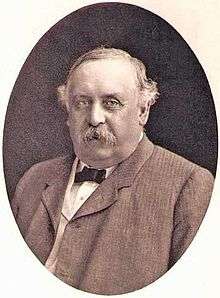George S. Morison (engineer)
| George S. Morison | |
|---|---|
 | |
| Born |
December 19, 1842 New Bedford, Massachusetts |
| Died |
July 1, 1903 (aged 60) New York, New York |
| Occupation | lawyer and civil engineer |
| Known for | bridge designer |
George Shattuck Morison (December 19, 1842 – July 1, 1903) was trained to be a lawyer, but became an engineer and the leading bridge designer of his time.
History
Born in New Bedford, Massachusetts, he was the son of John Hopkins Morison, a Unitarian minister. At age 14, he entered Phillips Exeter Academy and graduated by age 16. He went on to Harvard College where he was a classmate of philosopher John Fiske.[1] Morison received a Bachelor of Arts degree in 1863 when he was just 20. After a brief break he attended Harvard Law School where he would receive a Bachelor of Laws degree by 1866 and was admitted to the New York Bar. In 1867, with only general mathematics training and an aptitude for mechanics, he abandoned the practice of law and pursued a career as a civil engineer and builder of bridges. He would apprentice under the supervision of engineer Octave Chanute during the construction of the first bridge to cross the Missouri River, the swing-span Kansas City Bridge.
He is known for many steel truss bridges he designed, including several crossing the Missouri River, Ohio River and the Mississippi River. The 1892, Memphis Bridge is considered to be his crowning achievement, as it was the largest bridge he would design and the first bridge to span the difficult Lower Mississippi River.
Morison was a member of several important engineering committees, the most important of which was the Isthmus Canal Commission. He was instrumental in changing its recommended location from Nicaragua to Panama.
In the 1890s, he developed a series of lectures — inspired by reading his Harvard classmate Fiske's book The Discovery of America — on the transformative effects of the new manufacturing power of that era. He collected these lectures for publication in 1898, but they were not published until 1903, shortly after his death, under the title The New Epoch as Developed by the Manufacture of Power.[2]

Morison died in his rooms at 36 West 50th Street in New York, and was buried in Peterborough, New Hampshire, where he had a summer home (and designed the town library).[3]
He was the great-uncle of historian of technology Elton E. Morison (1909–1995).
See also
- Alton Bridge[4]
- Burlington Rail Bridge
- Cairo Rail Bridge
- Maroon Creek Bridge
- Frisco Bridge
- Taft Bridge
References
- ↑ Morison, George Shattuck (1903-01-01). The New Epoch as Developed by the Manufacture of Power. Houghton, Mifflin. p. vii.
- ↑ Morison, George Shattuck (1903-01-01). The New Epoch as Developed by the Manufacture of Power. Houghton, Mifflin.
- ↑ George S. Morison obituary, The New York Times
- ↑ Alton Bridge, Spanning Mississippi River between IL & MO, Alton, Madison, IL
- Historic American Engineering Record (Library of Congress) – Survey number HAER NE-2. 500+ data pages discuss Chief Engineer George S. Morison and his many bridges
External links
- Midwest bridges by Morison
- George S. Morison information at Structurae – Partial listing of Morison's Bridges
- Story of Morison's fight for the Panama location
- Personal stories by a descendant